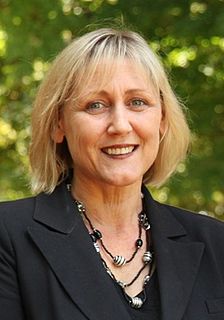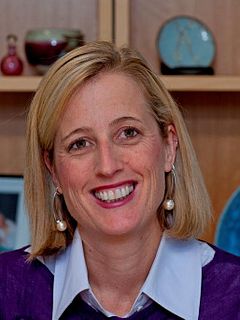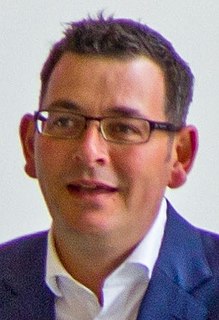
The Australian electoral system comprises the laws and processes used for the election of members of the Australian Parliament. The system presently has a number of distinctive features including compulsory enrolment, compulsory voting, majority-preferential instant-runoff voting in single-member seats to elect the lower house, the House of Representatives, and the use of the single transferable vote proportional representation system to elect the upper house, the Senate.

The Queensland Greens is a Green party in the Australian state of Queensland, and a member of the federation of the Australian Greens. The Greens were first founded in Queensland as the Brisbane Green Party in late 1984 about a month after the Sydney Greens. The Brisbane Green Party contested the March 1985 Brisbane City Council elections with four ward candidates and Drew Hutton as mayoral candidate. Hutton received 4 per cent across the city and the ward candidates received approximately 7-10 per cent. Some time after the collapse of the Brisbane Greens, a Green Independent campaign stood a further range of candidates in the Queensland state election, 1989.
Elections to the Australian Capital Territory Legislative Assembly were held on Saturday, 4 March 1989. This was the first direct election by voters in the Australian Capital Territory (ACT) for their own legislative body.
Vicki Ann Dunne, an Australian politician, is a member of the unicameral Australian Capital Territory Legislative Assembly, since 2001, representing the electoral district of Ginninderra for the Liberal Party.
Elections to the Australian Capital Territory Legislative Assembly were held on Saturday, 18 February 1995. The incumbent Labor Party, led by Rosemary Follett, was challenged by the Liberal Party, led by Kate Carnell. For the first time, candidates were elected to fill three multi-member electorates using a single transferable vote method, known as the Hare-Clark system. The result was another hung parliament. However the Liberals, with the largest representation in the 17-member unicameral Assembly, formed Government with the support of Michael Moore and Paul Osborne. Carnell was elected Chief Minister at the first sitting of the third Assembly on 9 March 1995.
Elections to the Australian Capital Territory Legislative Assembly were held on Saturday, 21 February 1998. The incumbent Liberal Party, led by Kate Carnell, was challenged by the Labor Party, led by Wayne Berry. Candidates were elected to fill three multi-member electorates using a single transferable vote method, known as the Hare-Clark system. The result was another hung parliament. However the Liberals, with the largest representation in the 17-member unicameral Assembly, formed Government with the support of Michael Moore, Paul Osborne, and Dave Rugendyke. Carnell was elected Chief Minister at the first sitting of the fourth Assembly on 19 March 1998.

Elections to the Australian Capital Territory Legislative Assembly were held on Saturday, 16 October 2004. The incumbent Labor Party, led by Jon Stanhope, was challenged by the Liberal Party, led by Brendan Smyth. Candidates were elected to fill three multi-member electorates using a single transferable vote method, known as the Hare-Clark system. The result was a clear majority of nine seats in the 17-member unicameral Assembly for Labor. It marked the first and so far only time in the history of ACT self-government that one party was able to win a majority in its own right. Stanhope was elected Chief Minister at the first sitting of the sixth Assembly on 4 November 2004. The election was conducted by the ACT Electoral Commission and was the second time in Australia's history that an electronic voting and counting system was used for some, but not all, polling places, expanding on the initial trial of the system at the 2001 ACT election.

The 2010 Victorian state election, held on Saturday, 27 November 2010, was for the 57th Parliament of Victoria. The election was to elect all 88 members of the Legislative Assembly and all 40 members of the Legislative Council. The incumbent centre-left Labor Party government, led by John Brumby, was defeated by the centre-right Liberal/National Coalition opposition, led by Ted Baillieu. The election gave the Coalition a one-seat majority in both houses of parliament.

Elections to the Australian Capital Territory Legislative Assembly were held on Saturday, 18 October 2008. The incumbent Labor Party, led by Jon Stanhope, was challenged by the Liberal Party, led by Zed Seselja. Candidates were elected to fill three multi-member electorates using a single transferable vote method, known as the Hare-Clark system. The result was another hung parliament with Labor winning seven seats, the Liberals six seats and the Greens finishing with four seats, giving the Greens the balance of power in the 17-member unicameral Assembly. On 31 October 2008, after almost two weeks of deliberations, the Greens chose to support a Labor minority government. Consequently, Labor was re-elected to a third consecutive term of government in the ACT. Stanhope was elected Chief Minister at the first sitting of the seventh Assembly on 5 November 2008.

The 2008 Western Australian state election was held on Saturday 6 September 2008 to elect 59 members to the Legislative Assembly and 36 members to the Legislative Council. The incumbent centre-left Labor Party government, in power since the 2001 election and led since 25 January 2006 by Premier Alan Carpenter, was defeated by the centre-right Liberal Party opposition, led by Opposition Leader Colin Barnett since 6 August 2008.
Shane Stephen Rattenbury, Australian politician and former Speaker of the ACT Legislative Assembly, is a member of the multi-member unicameral Australian Capital Territory Legislative Assembly representing the electorate of Molonglo for the ACT Greens since 2008. He was the first Speaker in any Parliament in the world representing a Green political party.

Amanda Bresnan is an Australian politician and a member of the Australian Capital Territory Legislative Assembly. Bresnan was elected to the ACT Legislative Assembly representing the electorate of Brindabella for the ACT Greens at the 2008 election and defeated at the 2012 election

Meredith Hunter, Australian politician, is a former member of the multi-member unicameral Australian Capital Territory Legislative Assembly representing the electorate of Ginninderra for the ACT Greens from 2008 to 2012. She was also the Parliamentary Convenor of the ACT Greens.
Caroline Le Couteur is an Australian politician. She was elected to the Australian Capital Territory Legislative Assembly representing the electorate of Molonglo for the ACT Greens at the 2008 election and defeated at the 2012 election In October 2016, she was re-elected to the assembly representing the new electorate of Murrumbidgee.

The 2014 Tasmanian state election was held on 15 March 2014 to elect all 25 members to the House of Assembly. The 16-year incumbent Labor government, led by the Premier of Tasmania Lara Giddings, sought to win a fifth consecutive term against the Liberal opposition, led by Opposition Leader Will Hodgman. Also contesting the election was the Greens led by Nick McKim. The Palmer United Party made a significant effort in the election.

Elections to the Australian Capital Territory Legislative Assembly occurred on Saturday, 20 October 2012. The 11-year incumbent Labor Party, led by Chief Minister Katy Gallagher, won a fourth term over the main opposition Liberal Party, led by opposition leader Zed Seselja.

A general election for the Australian Capital Territory Legislative Assembly was held on Saturday, 15 October 2016.

The 2018 Tasmanian state election was held on 3 March 2018 to elect all 25 members of the Tasmanian House of Assembly.

The 2018 Victorian state election was held on Saturday, 24 November 2018 to elect the 59th Parliament of Victoria. All 88 seats in the Legislative Assembly and all 40 seats in the Legislative Council were up for election.

A by-election for the seat of Northcote in the Victorian Legislative Assembly was held on 18 November 2017. The by-election was triggered by the death of Labor Party MP Fiona Richardson on 23 August 2017. While the seat historically has firmly been in the Labor Party's hands since its inception in 1927, environmental issues, rising house prices and demographic trends have resulted in a stronger Greens vote at recent elections. The Liberal Party elected not to field a candidate.
















